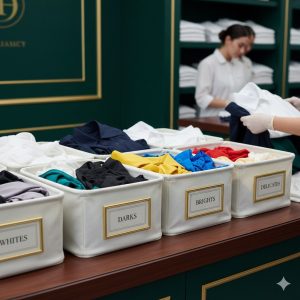Professional Laundry Services Hampstead – The Ultimate 2025 Laundry Care Guide (Black Friday Edition)
Professional Laundry Services Hampstead
 Professional Laundry Services Hampstead exists because, although most people think laundry is easy — you throw clothes in the machine, add detergent, press start, and walk away — the reality is much more complicated. But if you’ve ever ended up with faded colours, shrunken jumpers, rough towels, or a duvet that never quite dries, you already know the truth — good laundry care is not that simple. Small mistakes in temperature, sorting, drying, or detergent use can quietly damage fabrics over time, even if everything looks fine straight out of the machine.
Professional Laundry Services Hampstead exists because, although most people think laundry is easy — you throw clothes in the machine, add detergent, press start, and walk away — the reality is much more complicated. But if you’ve ever ended up with faded colours, shrunken jumpers, rough towels, or a duvet that never quite dries, you already know the truth — good laundry care is not that simple. Small mistakes in temperature, sorting, drying, or detergent use can quietly damage fabrics over time, even if everything looks fine straight out of the machine.
Behind every wash there is real science: water chemistry, fabric behaviour, temperature control, drying speed, and hygiene. Different fibres — like cotton, linen, wool, silk, and synthetics — all react differently to water, detergent, and heat. Some fibres swell, some shrink, some stretch, and some lose colour quickly. If you treat all fabrics the same, you will eventually ruin something you care about.
As London moves into winter 2025 and Black Friday offers begin at Hampstead Garment Care, choosing Professional Laundry Services Hampstead becomes a smart way to protect your clothes, bedding, and towels and to stop guessing with home laundry settings. Instead of guessing at settings or hoping a “mixed load” will somehow work for everything, you can rely on trained professionals, calibrated machines, and carefully chosen detergents. This guide explains, in clear, simple terms, why professional laundry is so essential in winter, how it works behind the scenes, and why it often delivers better results than a home washing machine.
Why Professional Laundry Services Hampstead Matter More in Winter 2025
 Winter in London completely changes how laundry behaves. Cold air, closed windows, central heating, and higher indoor humidity all work against you, making it much harder for fabrics to dry correctly. A T-shirt that dries in two hours in August might take a full day or more in December, especially in a small flat with limited airflow. During that long drying time, the fabric stays damp, and that extra moisture becomes a problem for both your clothes and your home.
Winter in London completely changes how laundry behaves. Cold air, closed windows, central heating, and higher indoor humidity all work against you, making it much harder for fabrics to dry correctly. A T-shirt that dries in two hours in August might take a full day or more in December, especially in a small flat with limited airflow. During that long drying time, the fabric stays damp, and that extra moisture becomes a problem for both your clothes and your home.
When fabric stays damp for too long, it becomes the perfect place for bacteria and mould to grow. Moisture trapped in cotton, towels, and bedding can lead to:
- Bacteria and germs are multiplying inside the fibres
- Mould spores are developing, which can trigger allergies
- Musty or “sour” smells that don’t disappear easily
- Yellow stains are appearing over time
- Fibre weakness and damage, especially in cotton and elastic
To save money or energy, many people hang wet laundry around the house instead of using a tumble dryer, especially in winter when heating and electricity bills are higher. They assume the clothes will dry slowly but safely in warm rooms, so they spread items wherever there is space:
- On radiators
- Over doors
- In spare rooms with poor ventilation
- On airers in the living room
At first, this looks harmless, but it creates a constant layer of moisture in the air. This moisture can collect on windows, walls, and cold corners, leading to condensation, damp patches, and even black mould. Meanwhile, cotton clothes and towels stay moist for hours, sometimes all day, and the fibres never fully “relax” and dry out. That familiar sour smell many people blame on the machine is not “just damp” — it is bacteria growing in the fabric and releasing unpleasant odour molecules.
This is one of the main reasons more households choose Professional Laundry Services Hampstead in winter. With industrial washing machines, powerful dryers, and sanitising wash programs, professional systems get items spotless, thoroughly rinsed, and fully dry, all in a controlled environment. Garments come back softer, fresher, and more hygienic — without the risk of damp air damaging your home or your wardrobe.
Professional Laundry Services Hampstead vs Dry Cleaning – Why Laundry Needs Real Skill
 Many people think dry cleaning is the “clever” process, and water-based laundry is basic. In reality, poorly done water-based laundry can cause more damage than dry cleaning, because water changes the shape and structure of fibres in ways solvents don’t. When water enters a fabric, it can swell the fibres, disrupt the weave, and cause dyes to move around. If the process is not controlled carefully, the garment can come out smaller, rougher, or the wrong colour.
Many people think dry cleaning is the “clever” process, and water-based laundry is basic. In reality, poorly done water-based laundry can cause more damage than dry cleaning, because water changes the shape and structure of fibres in ways solvents don’t. When water enters a fabric, it can swell the fibres, disrupt the weave, and cause dyes to move around. If the process is not controlled carefully, the garment can come out smaller, rougher, or the wrong colour.
Water can:
- Expand and distort fibres, especially cotton and wool
- Dissolve or bleed dyes, leading to colour runs
- Shrink fabrics when high heat or long cycles are used
- Fade colours over time with repeated hot or harsh washes
- Weaken cotton if washing is too hot or too aggressive too often
- Trap odours if items dry too slowly or never fully dry
Dry cleaning uses solvents instead of water, so fibres don’t swell in the same way. That is why many “dry clean only” items keep their shape better over time when properly cared for. Laundry uses water directly, which means temperature, time, mechanical action, and detergent chemistry must all be controlled carefully to avoid damage. Simply choosing a random program and hoping for the best is risky.
That’s why Professional Laundry Services Hampstead follows clear, tested procedures for every step of the process:
- Setting the proper water temperature and wash length for each type of item
- Choosing the correct detergent type and dosage based on the soil level and fabric
- Respecting fabric sensitivity and constantly checking care labels
- Adjusting spin speed and drum movement to avoid rough treatment of delicate items
- Separating colours, fabrics, and soil levels instead of mixing everything
- Removing enough water before drying so items dry quickly and evenly
- Setting safe, fabric-appropriate drying temperatures to prevent shrinkage and hardening
When done correctly, professional laundry is gentler, cleaner, and more consistent than most home washes. When poorly done, it is precisely how favourite clothes shrink, fade, twist out of shape, or feel rough after just a few washes.
The Science of Sorting with Professional Laundry Services Hampstead – The Step Most People Skip
 Sorting is the most crucial step in proper laundry care, and it’s the step most people rush or skip. If sorting is wrong, even the best washing machine, the most expensive detergent, and the latest “eco” settings cannot fully protect your clothes. Sorting is not just about colours; it also involves fabric type, weight, and the level of dirtiness of each item.
Sorting is the most crucial step in proper laundry care, and it’s the step most people rush or skip. If sorting is wrong, even the best washing machine, the most expensive detergent, and the latest “eco” settings cannot fully protect your clothes. Sorting is not just about colours; it also involves fabric type, weight, and the level of dirtiness of each item.
Sorting by Colour
Colour bleed happens when excess dye from one garment leaves the garment, mixes with the wash water, and then transfers to other items in the same load. Once this happens and the dye sets, it can be challenging, if not impossible, to reverse entirely.
Real examples you’ve probably seen or heard of:
- A new red dress, turning a whole load of T-shirts and socks light pink
- Navy hoodies slowly release blue dye in mixed washes, so lighter items look dull over time
- Black cotton joggers are losing dye during their first few washes, making the grey pieces look “dirty.”
To reduce the risk of colour transfer, it helps to follow some basic colour-sorting rules every time you wash:
- Whites only with whites, especially shirts, bed sheets, and towels
- Darks with darks, including black, navy, deep green, and dark grey
- Bright colours together, especially brand-new items that haven’t been washed much
- Pastels together, as they are lighter and more sensitive to strong dyes
- Very intense new colours washed alone at first, so any extra dye leaves the garment without ruining anything else
In Professional Laundry Services Hampstead, whites, lights, darks, and brights are always separated. On top of that, special products such as colour stabilisers or colour-catcher systems can be used to help hold dyes in place and further reduce the risk of dye transfer, especially for new or sensitive garments.
Sorting by Fabric Type
Fabrics don’t just look different — they behave differently in water, in the drum, and in the dryer. Mixing the wrong fabrics in one load can cause physical damage, poor drying, and rough textures. Thicker, heavier items can hit lighter fabrics during the spin, and rough textures can rub against smooth surfaces, causing pilling and snags.
Common problems when you mix the wrong fabrics include:
- Towels are releasing a lot of lint that sticks to leggings, pyjamas, and polyester tops, making them look old and dusty
- Jeans and hoodies, which are heavy, bash delicate fabrics in the drum and wear them out much faster
- Polyester dries much faster than cotton, which can cause uneven drying, bad smells, and rough areas if washed and dried together
- Silk or satin pillowcases snagging or losing their shine when washed with rough fabrics like towels or denim
Sorting by fabric type helps protect several key things:
- The surface of the fabric remains smooth and free of pilling and snags
- The shape and drape of the garment, so that it hangs properly on the body
- Overall, the fibre strength means he item lasts longer before wearing out
- The long-term look and feel of the item, which is essential for luxury and favourite pieces
In professional systems, similar fabrics are washed together, and cycles are chosen based on fibre type, not just on the basic “mixed load” or “cottons” options on a household dial. This means wool gets a different treatment from cotton, and sportswear is dealt with differently from heavy denim or towels.
Sorting by Soil Level
Sorting by how dirty items are is just as important as sorting by colour and fabric. If you wash heavily soiled items with lightly soiled clothes, you risk spreading dirt and bacteria rather than removing them. The wash water becomes overloaded, and lighter items can come out looking or smelling worse than before.
Heavily soiled items should never be washed with lightly worn clothes. For example:
- Muddy children’s clothing after outdoor play or sports
- Gym wear soaked in sweat after repeated workouts
- Kitchen cloths and tea towels that have touched food, oil, or raw meat
- Cleaning rags and mop heads used on floors, bathrooms, or dusty areas
These items often carry a lot of bacteria, strong odours, and sometimes oils or grease that are difficult to remove. Washing them together with lightly worn shirts, blouses, or bedding spreads can spread bacteria and grime across the whole load and can even push some of it deeper into delicate fibres.
Professional Laundry Services Hampstead separates items by soil level and hygiene needs as a fundamental part of their routine. Heavily soiled pieces receive:
- Higher temperatures are safe for the fabric
- Stain treatment either before the wash or during the primary cycle
- Longer or more powerful wash programs are designed for deep cleaning
Lightly worn items are washed on gentler cycles with lower mechanical action and sometimes lower temperatures, which helps reduce wear and tear and keeps fabrics feeling new for longer.
How Professional Laundry Services Hampstead Stop Colour Bleeding – Before, During & After Washing
 Colour transfer is one of the main reasons people bring clothes to professional cleaners in a panic. A single wrong wash can turn a favourite white shirt permanently pink or make a set of pastel tops look dull and tired. The good news is that many of these problems can be prevented with a few simple habits.
Colour transfer is one of the main reasons people bring clothes to professional cleaners in a panic. A single wrong wash can turn a favourite white shirt permanently pink or make a set of pastel tops look dull and tired. The good news is that many of these problems can be prevented with a few simple habits.
Before Washing
Before you even press start, you can reduce the risk of colour bleeding by:
- Testing colourfastness on new or bright items: rub a damp white cotton pad on a hidden area, such as an inside seam, and check whether any colour transfers.
- Turning dark or bright garments inside out before washing: this reduces friction on the visible outer surface and helps colours stay rich for longer.
- Using cool water (around 20–30°C) for coloured items when the care label allows it: cooler water is gentler on dyes and reduces the rate at which they move into the wash water.
During the Wash
Once the machine is running, a few extra details make a big difference:
- Use colour-catcher sheets to help trap loose dye floating in the water before it reaches other garments.
- Avoid using too much detergent — excess detergent increases friction and residue, which can strip colour and make garments feel rough.
- Choose a gentle spin for delicate fabrics, so the fibres don’t rub against each other too aggressively.
- Don’t overload the drum — clothes need space to move freely so dirt and dye can rinse away instead of redepositing.
If Colour Transfer Has Already Happened
The classic mistake: a red sock turns a white shirt light pink, or a dark blue item dulls a set of pale tops.
Steps you can try at home include:
- Rewash the stained items immediately in cold water before the dye fully sets into the fibres.
- Use an oxygen-based whitening product (not chlorine bleach) to gently lift the unwanted colour, especially from white or light items.
- For colourfast fabrics only, you can try a short soak in a mild vinegar + water solution to help release some of the loose dye.
- If the item is excessively expensive or sentimental, bring it straight to Professional Laundry Services Hampstead. Professional processes can often improve or partially reverse dye transfer,pr primarily if the problem is addressed promptly.
How Professional Laundry Services Hampstead Washes Bedding, Sheets & Duvet Covers
 Bedding is often treated like everyday laundry, but it actually needs more careful handling. You sleep in it every night, usually for 6–8 hours, so it slowly absorbs a mixture of sweat, body oils, skin flakes, dust, and even tiny particles from the air. Over time, this build-up can affect both hygiene and comfort.
Bedding is often treated like everyday laundry, but it actually needs more careful handling. You sleep in it every night, usually for 6–8 hours, so it slowly absorbs a mixture of sweat, body oils, skin flakes, dust, and even tiny particles from the air. Over time, this build-up can affect both hygiene and comfort.
You might not see the dirt clearly, especially on coloured or patterned sheets, but it’s there. That’s why bedding needs regular, thorough washing, not just a quick freshen-up.
Best Temperatures
Choosing the right temperature is a balance between fabric care and hygiene:
- White cotton bedding: usually best at 60°C (always check the care label). This temperature helps kill bacteria and dust mites, and is one reason hotel bedding feels so fresh.
- Coloured or printed bedding: often washed at 40°C, or up to 60°C if the label says it’s safe. This protects prints and dyes while still cleaning effectively.
Hotels choose higher temperatures because hygiene matters more than anything else in shared environments. At home, many people wash bedding too cool, too fast, or not often enough, and then wonder why their sheets start to look dull or smell stale.
Detergent Choice
The detergent you choose also affects how your bedding ages:
- Use a good-quality, non-chlorine detergent that is strong enough to clean but not so harsh as to damage fibres.
- Avoid using bleach regularly — it can slowly yellow cotton, damage elastic in fitted sheets, and weaken fibres, making them more likely to tear.
Spin Cycle
- A medium spin speed usually works best for bedding. It removes enough water to help with drying, but does not twist the fabric so hard that it becomes extremely creased or stressed.
Drying
Drying is one of the most critical stages for bedding:
Air-drying bedding indoors during winter can cause:
- Sour or stale smells that are difficult to remove later
- Fabrics that feel slightly damp or cold, even when you think they are “dry”
- Mould in the corners of the room or around windows due to excess moisture
- Yellowing or dullness over time, especially in white cotton
At Hampstead Garment Care, bedding sent to our Professional Laundry Services in Hampstead goes through a much more controlled process:
- Properly loaded, high-capacity machines that allow sheets to move freely
- Thorough rinsing to remove detergent, sweat, and body oils
- Strong but carefully controlled spin cycles to remove excess water
- Commercial dryers that obliterate moisture and leave cotton soft, fluffy, and ready to go straight back onto the bed, often with a freshly pressed finish.
Why Dryers at Professional Laundry Services Hampstead Are So Important in Modern Laundry
 Many people believe air-drying is always gentler and more eco-friendly. In some situations, like a warm, breezy summer day, that can be true. However, in a cold, damp London winter, relying solely on indoor air-drying can actually cause more problems than it solves, both for your clothes and your home.
Many people believe air-drying is always gentler and more eco-friendly. In some situations, like a warm, breezy summer day, that can be true. However, in a cold, damp London winter, relying solely on indoor air-drying can actually cause more problems than it solves, both for your clothes and your home.
Complete Moisture Removal
Proper tumble drying, using the correct settings for the fabric, makes sure moisture leaves the fabric thoroughly. This helps prevent:
- Odour build-up from bacteria living in damp fibres
- Bacterial growth that can irritate the skin or cause infections
- Mould spores are forming in thicker items like towels or hoodies
- Fibres are becoming stiff, scratchy, or “board-like” as they dry too slowly
Restoring Softness
When cotton dries very slowly, its fibres can collapse, stick together, and harden. In a dryer, the movement of the drum helps separate and fluff the fibres, which is why professionally dried:
- Towels
- Bedding
- Sweatshirts and loungewear
Often feel much softer than items line-dried indoors in winter. The controlled heat and movement work together to bring back the smooth, comfortable texture people love.
Reducing Wrinkles
Taking clothes out of the dryer at the right time also reduces deep wrinkles and heavy creases. When combined with professional pressing and finishing, it gives you that smooth, hotel-style finish you rarely achieve at home without spending a lot of time ironing.
Reducing Bacteria
Heat from controlled tumble drying can help reduce bacteria, which is especially important for items that regularly come into contact with sweat, skin, or moisture, such as:
- Gym and sportswear
- School uniforms are worn all day
- Towels used in bathrooms and kitchens
- Bedding for people with allergies or sensitive skin
This is where Professional Laundry Services Hampstead really stands out. Domestic radiators, overcrowded clothes airers, and “quick dry” hacks cannot compete with correctly set commercial dryers that balance temperature, time, and movement for each load type.
How Professional Laundry Services Hampstead Prevents Bad Laundry Odours
 That “wet dog” or sour laundry smell is not a mystery, and it is not always the fault of the washing machine brand. It is usually a combination of bacteria, leftover dirt, and trapped moisture that never entirely leaves the fabric. Once this smell has built up, it can be hard to remove, so prevention is much easier than cure.
That “wet dog” or sour laundry smell is not a mystery, and it is not always the fault of the washing machine brand. It is usually a combination of bacteria, leftover dirt, and trapped moisture that never entirely leaves the fabric. Once this smell has built up, it can be hard to remove, so prevention is much easier than cure.
Key rules to avoid foul odours include:
- Never leave wet laundry sitting in the machine once the cycle ends. Take it out as soon as you can, so it doesn’t sit in warm, damp conditions.
- Don’t overload the machine: if it’s too full, clothes won’t rinse properly or spin effectively, and dirt and detergent residue will remain.
- Use the right amount of detergent — too little leaves dirt behind, too much leaves a sticky layer of residue that traps odours and irritates skin.
- Always dry clothes thoroughly and as quickly as possible, whether you use a tumble dryer or a well-ventilated drying area.
- Avoid drying clothes in small, closed rooms with no airflow, especially in winter, as this increases humidity and slows the drying process.
At Hampstead Garment Care, our Professional Laundry Services Hampstead are designed around these principles. We use:
- Correct loading levels for each machine, so water and detergent can circulate properly
- Precise detergent dosing systems, so every load gets just the right amount
- Carefully programmed wash cycles that match the fabric and soil level
- Commercial dryers are set to the right time and temperature for each type of garment
Because of this, items leave our care clean, dry, and odour-free, ready to wear, fold, or store without any extra work on your part.
Why Black Friday Is the Ideal Time to Use Professional Laundry Services in Hampstead
 Black Friday is usually linked to electronics, gadgets, and fashion, but it’s also the best time of year to upgrade how you handle your laundry. Instead of just buying more clothes, you can invest in keeping the clothes and linens you already own in better condition for longer.
Black Friday is usually linked to electronics, gadgets, and fashion, but it’s also the best time of year to upgrade how you handle your laundry. Instead of just buying more clothes, you can invest in keeping the clothes and linens you already own in better condition for longer.
Black Friday is a great moment to try Professional Laundry Services Hampstead because several challenges all hit at once:
- Winter laundry at home is more complex, slower, and often less hygienic due to poor drying conditions.
- Indoor drying increases damp, mould risk, and bad smells, which can affect your health and your home.
- Energy bills are already high — repeating long, hot wash-and-dry cycles at home costs more than many people realise.
- Families wash more during term-time: school uniforms, PE kits, sportswear, and extra winter layers like hoodies and coats.
- Bedding, blankets, and throws are used every day and need regular, deeper cleaning to stay fresh and hygienic.
- Large items like duvets and mattress protectors are uncomfortable or sometimes impossible to wash and dry properly at home.
With Black Friday offers at Hampstead Garment Care, you can:
- Clear a huge laundry backlog in a single collection and delivery, freeing up time and space at home.
- Refresh bedding and towels before visitors arrive, so your home feels hotel-fresh for guests.
- Put school uniforms, gym wear, and baby clothes on a regular professional cycle to reduce your weekly workload.
- Enjoy hotel-level freshness at home without paying full hotel prices for cleaning or replacement.
Why Hampstead Garment Care and Professional Laundry Services Give Better Laundry Results
So what really makes Professional Laundry Services Hampstead different from just “doing a big load” at home on your usual machine? The difference is in the combination of equipment, knowledge, and process — each step is chosen deliberately, rather than guessed.
At Hampstead Garment Care, we use:
- Industrial sanitising wash cycles designed to balance hygiene and fabric safety, not just speed
- Fabric-specific detergents and boosters for cotton, synthetics, delicate fibres, sportswear, and more
- Colour stabilisers and brighteners, where appropriate, to keep whites bright and colours vivid
- Strict separation by colour, fabric type, and soil level, so each item gets the proper treatment
- Accurate temperature control based on care labels and fibre content, reducing shrinkage and fading
- High-powered extraction to remove as much water as possible before drying, shortening drying time and reducing odour risk
- Commercial dryers with sensors to avoid under-drying (which leads to damp) or over-drying (which can make fibres brittle)
- Professional pressing, folding, and packing, so items arrive ready to wear, stack, or store with no extra effort
This careful process gives you:
- Longer life for garments and household linens, so you replace items less often
- Brighter whites and more stable colours that look new for longer
- Softer fabrics that feel better on your skin and are more pleasant to wear or sleep in
- No dampness, no sour smells, and fewer allergy triggers from badly dried fabrics
- Less shrinkage and fewer shape changes, so clothes still fit properly after many washes
- Much less laundry stress at home, freeing up your time and space
Professional care does more than clean your clothes — it protects your wardrobe and household textiles over time, mainly if you invest in quality pieces.
Conclusion – Winter Laundry, Under Control
Laundry is not only about getting rid of visible dirt, and this is precisely where Professional Laundry Services Hampstead makes a difference. It is about protecting fibres, keeping colours strong, and maintaining hygiene, especially in winter when drying is more difficult and fabrics stay damp for longer. Small choices in how you wash and dry your items can significantly impact how long they last and how they feel against your skin.
London winters make all of this harder: drying is slow, humidity is higher, and heavy fabrics like hoodies, towels, and bedding take much longer to dry indoors. Radiators and clothes airers can only do so much before your living space starts to feel damp and cluttered.
By choosing Professional Laundry Services Hampstead at Hampstead Garment Care, you are not just paying someone else to wash your clothes. You are selecting a controlled system that looks after your wardrobe and home textiles in a more scientific, careful way. Every stage — from sorting to washing, rinsing, drying, and finishing — is managed to protect both the fabric and your comfort.
With Black Friday offers running, this is the perfect time to:
- Stop dealing with damp laundry hanging over radiators and blocking the living space
- Protect your bedding, towels, uniforms, and everyday garments the right way
- Enjoy professional-level cleanliness, softness, and finishing at a lower seasonal price and see the difference for yourself.
When you are ready for your laundry to behave this winter, finally, and you want to experience the difference that Professional Laundry Services Hampstead can make, Hampstead Garment Care and our Professional Laundry Services Hampstead are here to handle it properly — from the first wash to the final fold, so you can focus on living your life, not fighting with your laundry.




No comment